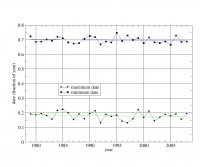By Roger Pielke Sr., Climate Science
The use of Arctic sea ice coverage as a climate metric has received wide science and media coverage. This issue is motivated by the recent large reduction in late summer areal coverage (e.g. see the data on the excellent website The Cryosphere Today).
There is another sea ice metric to look at, however, and that is the date of the year of the minimum and maximum sea ice coverage. With the addition of well-mixed greenhouse gases into the atmosphere, we should expect the start of the freeze-up in the late summer/early fall to be later and the start of the melt in the late winter/early spring to be earlier.
Indeed, this is what is claimed in a recent talk by Mark C Serreze of the Cooperative Institute for Research in Environmental Sciences/National Snow and Ice Data Center (CIRES/NSIDC) at the University of Colorado Boulder (November 10 2008 - titled “The Emergence of Arctic Amplification"), where his abstract reads:"The concept of Arctic amplification is that rises in surface air temperature in response to increasing atmospheric greenhouse gas concentrations will be larger in the Arctic compared to the Northern Hemisphere as a whole. Model-projected Arctic amplification is focused over the Arctic Ocean. As the climate warms, the summer melt season lengthens and intensifies, leading to less sea ice at summer’s end. Summertime absorption of solar energy in expanding open water areas increases the sensible heat content of the ocean. Ice formation in autumn and winter, important for insulating the warm ocean from the cooling atmosphere is delayed.”
The abstact includes the statement “As the climate warms, the summer melt season lengthens” In order to explore this issue further William Chapman, author of The Cryosphere Today website, graciously prepared an analysis of the dates of the minimum and maximum Arctic sea ice coverage since 1979. The plot of this data and the individual values in fraction of the year are presented below.

See larger size image here
The finding in this data is that there is no clear evidence of a delay in the start of the later summer/early fall freeze up or the start of the late winter/early spring melt despite the well below average areal sea ice coverage.
A priority in the climate modeling community should be an examination of their predictions of trends in the start of freeze up and start of melt dates, in order to see how they conform to the observational data. Also, the reason that the added atmospheric concentrations of well-mixed greenhouse gases are not changing the dates as expected needs to be provided. Read full post here.


